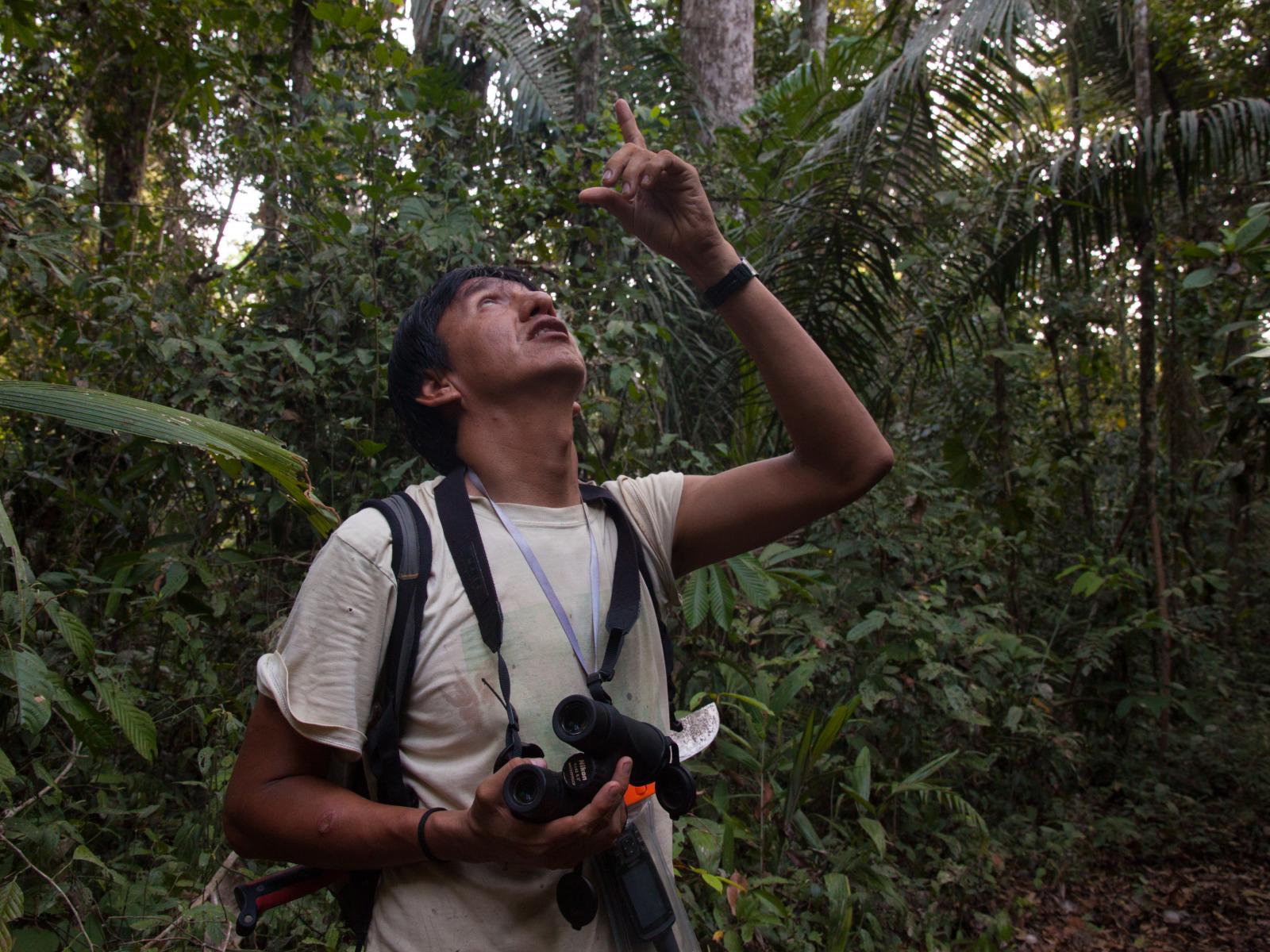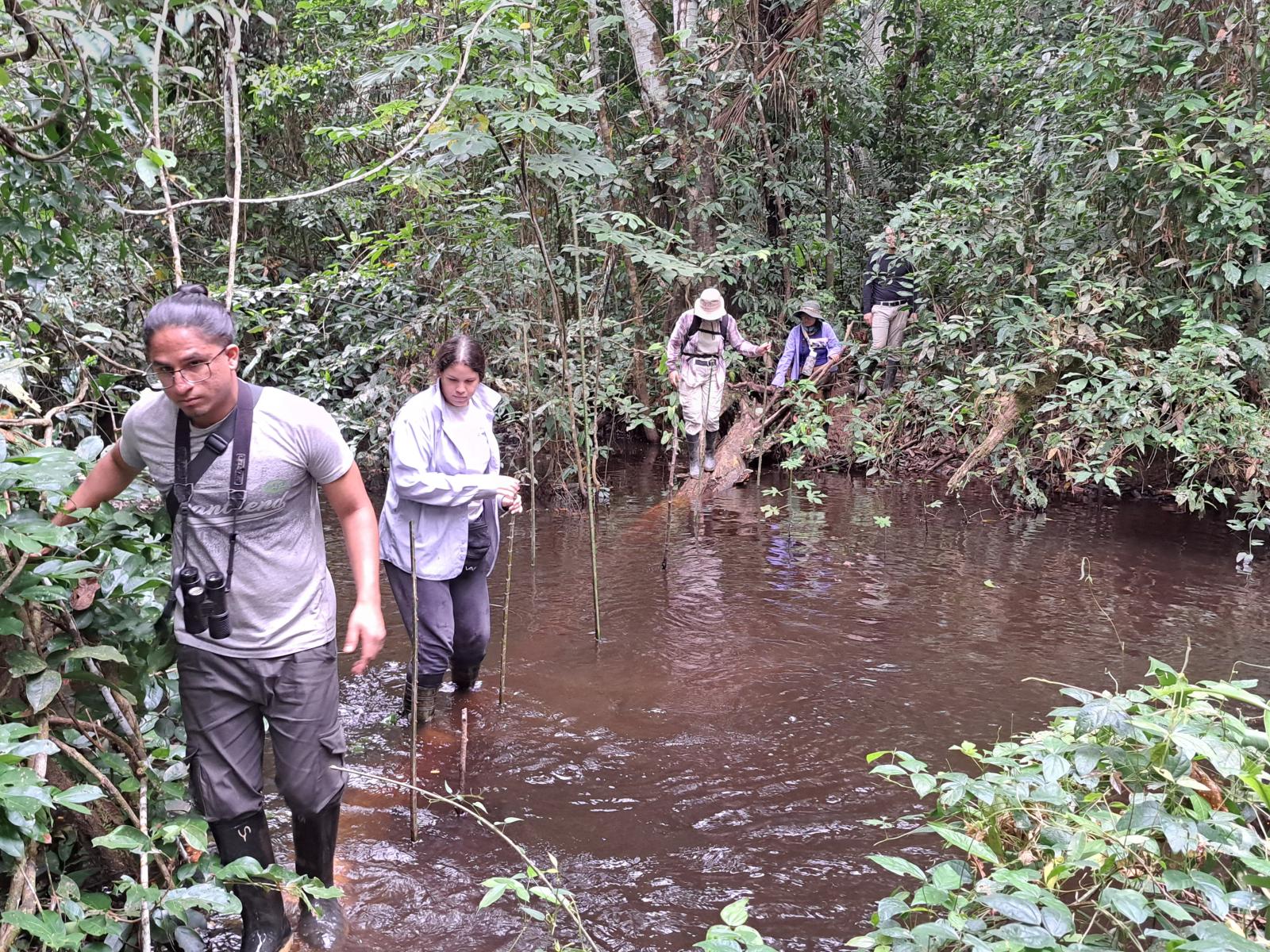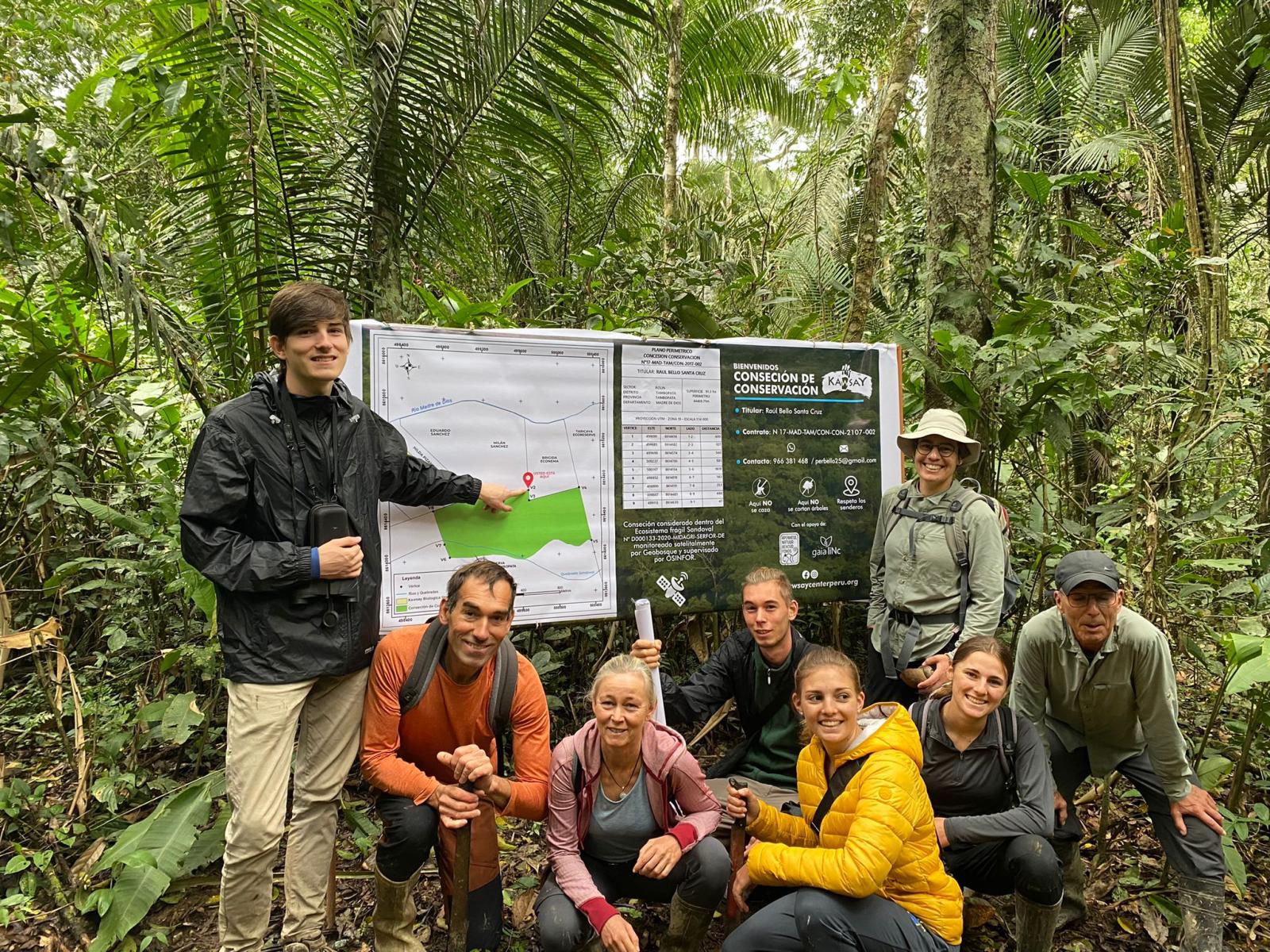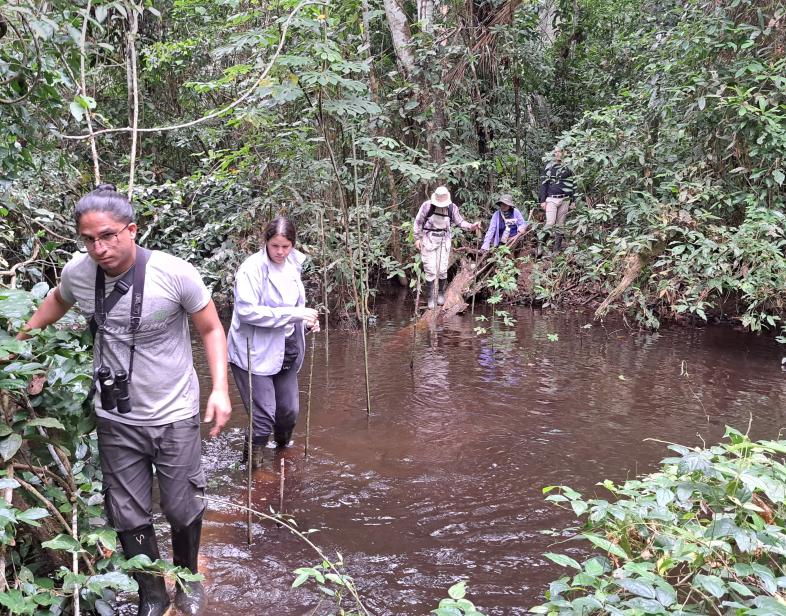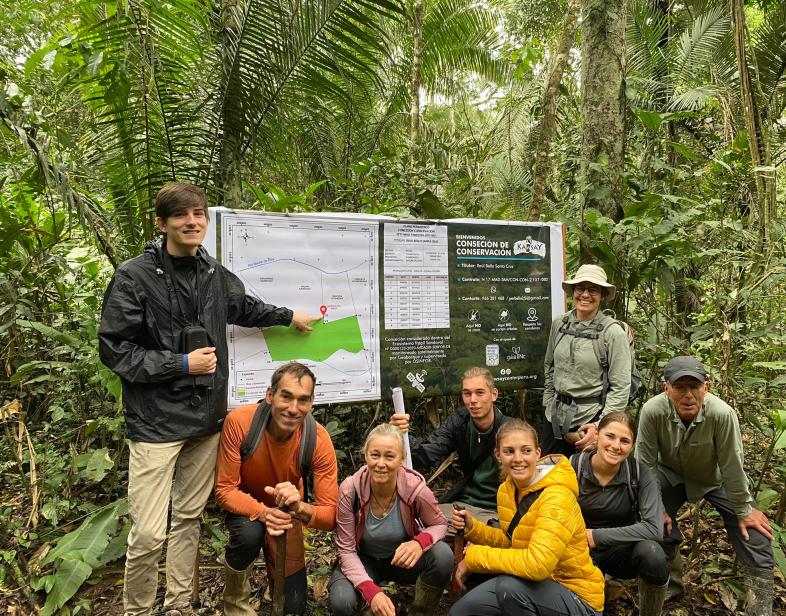An Overview Of Our Solution
Kawsay Biological Station was created with the aim to protect our concesion conservation forest, protect and study a reintroduced groups of spider monkey, promote and doing research and training local students.
We established a control and surveillance monitoring, wildlife monitoring, and capitation program, designed in such a way that doing science and participating in conservation efforts is accessible to our different types of visitors. activities with purpose, Protecting the forest from illegal activities while collecting data and studying the forest are done. ensure the protection and viability of reintroduced spider monkeys, individuals that were rehabilitated in a breeding center, rescue from trade and have had a second chance. it has been possible to form a stable group where it was wildly extinct and maintain long-term monitoring
- Population Impacted: since 2018, 70 local student were supporting and training by us and More than 300 visitors/Tourist and participants of the station, leand and help about oue effort. More than 2000 followers on Instagram and 6000 on Facebook
- Continent: South America
Prénom
Nom de famille
Type d'organisation
Courriel
Analyse du contexte
when i worked at taricaya rescue center in Puerto Maldonado (2008-2016) rehabilitating wildlife animals that come from trade and traffic, animals were rescue or giving for the wiildlife deparment in Madre de Dios. In 2009 we started a reintroduction program of the Endagered black face spider monkey (Ateles chamek), that was local extinc in the low part of the River Madre de Dios. we wanted to demostrate that rescue spider monkey are able to back to the forest and form as stable population in the area. Since the first release until now several groups were release with diferent rate of succes, but at the end we were able to recuperate an stable popublation in the area.
In 2017 i get a conservation concesion forest, and in 2018 i create Kawsay Biological Station in the area that the reintroduce spider monkeys use now, with the aim to protect them and study the ecological requeriments of this population and training local students. i did my master thesis describing the behaviour during the adaptation process. since we get our land no more selecting logging activities happened in our forest. Maintenance long term monitoring of the reintroduce spider monkeys allow to us report alredy 18 births in the wild and the last 3 babies from the ones that already born in freedom. One of our main activities is monitoreing the reintroduce groups while we training local students in primatologist, conservations, reintroduction issues. We collect data of their behavior, diet, habitat used, and reporting diferente importan events. keep giving oportunities to training local students while monitoring the monkeys will make them better profesionals as understanding all the process. Also we open a scientic tourims activity for diferent participant join us follow the reintroduced spider monkeys, collect data and sharing with them about primate trafficking, conservation effort and good example of reintroduction with animals that were pets, that second chances are possible.
Décrivez la solution technique que vous voudriez voir le public cible adopter.
for the diferente participants that visit the Station, to undernstand all the process that confiscated animal have to pass since they arrrive to captivity until be free, with a case example of the spider monkeys. visit them in the forest after been in captivity is emotional, a big message. also becouse only few of them will made it. that is not easy to get back and be free, that is important to do not have animals as pet.
to our local students give all the information and training posible in the field, for they be able to undernstad and be part of the solution and message in their home, comunity, university and profession.
to keep maintenance the legal protection of our forest, controling ilegal activities as hunting and selecting logging by patroll and survillance activities in company of our visitors and studentds, to make them part of it.
Décrivez votre intervention comportementale.
we motivated them by showing real results and example. to avoid them stop having animals as pet by sharing their experience after they see some animals that were posible to get back to the forest after been traffiking or pet.
We make them be part of all the conservation effort that we do: protecting the cover forest by patroll and survillnace activities, study the flora y fauna of the fores (diversity and abundance) and keep having a long term monitororing studies with the reintroduced spider monkeys.
also we have teorical lesson and conversatory of local problems in Madre de Dios, talking about, selecting loggin and gold mining activities and their impact in the ecossystem.
Leviers comportementaux utilisés
Au besoin, veuillez expliquer comment vous avez utilisé le ou les leviers avec plus de détails.
- giving Hope, that there is oportunity to some of the animale to get back to the forest. that they suffer a lot, that their journey was dificult and complex until they finally free and adapted well to the forest.
- prospete of shame, about having wildanimals as pet, the health problems relate to primates and humans.
- we explain the protocols for the diferent stages (rehabilitation, release preparation, permission, post monitoring release), that the animals have to envolve and the importance of them on the ecossystem
- we give field experiences in diferent topyc and metodology to study wildlife
Décrivez votre mise en œuvre.
-Giving legal protection to the fores that the reintroduced spider monkey were using. the area was heavy impact by selecting logging. this ilegal activity stop since our presence in the area in 2017-2018.
- we install patroll and survillance activities in company with our students and participants.
- we keep constant long term monitoring studies in the reintroduce groups, while we training local students and sharing this experiences with out visitors/participants
- we maintenance constant presence also doing other activites that cover the area of our forest, such us camera traps in clay licks, mammal transect, phenology transect, vegetattion plots, trail maintenance.
- All participants are part of the activities. they have the change to see from inside direct conservations effort for protecting the spider monkeys and the forest.
- We have demarcated our vertices, edges, we have placed information panels within the concession
Décrivez le leadership de votre solution. Qui dirige la mise en œuvre?
at the moment i am the head of the leadership.
i am peruvian biologist and have a master science in conservation of natural resources. now having my own conservation consecion forest with a biological station, thats was create with the aim to protect the forest and the spider monkeys, to promote and do research and training local students.
as a head of this projets we train a lot of local students, given them the confidence and help in their projects, former future leadership. in our station they youth are responsable of the activities and of their own project too. they learn how to work in team under field conditions. already 70 local students suported by us.
Principaux intervenants et partenaires du programme
- we have a cooperation agreement with Tambopata National Reserve and AIDER. this allow to us to monitoring the monkeys when they are inside the protect area. becouse the home range of the monkey now is around 200 ha and part of it is in Tambopata Reserve.
- Taricaya rescue center, is responsable of the care and rehabilitation and release of the spider monkeys.
- we get some small grants support for keep given oportunities to train local students in the last 2 years.
-in 2019 we get support from the goberment for build 2 bungalows and buy field materials for our participants and program as a part of scientific tourims proposal
- we were part on the consulting team for preparing the protocols for primates traslocations in Peru leading by SERFOR, document thats is in the final part of approval.
Qui a adopté le(s) comportement(s) souhaité(s) et dans quelle mesure?
- the students that were part of our programs, at the end of their time (2 to 4 months) their are able to conduct field work by their self. We are part of the strengthening of their capacities in conservation, reintroduction, research and other topics. we make a qualitative comparison of how they got there to how they came out, and the difference in their understanding and capabilities in the field.
- the visitor and participants of our station. the experience lived is very important, they want to continue supporting this type of initiatives, they leave motivated by what they have seen and learned
Quel a été votre impact sur la pollution de l'eau?
- as i mention before. since 2017, not more selecting logging activity was register in our consecion forest. 177ha keep protect.
- we were able and help to recuperate one population of spider monkey in an area that were local extinct. they are important seed disperse, bringing back this population in this area after more than 40 years, will helphelping in maintenance the composicon and natural regeneration of the forest.
- as a part of monitoring program of wildlife (flora and fauna), we understand better our forest. many tecnical report for locals student was made it, some undergrate and postgraduate thesis was made too. also some scientific journal publication was made it.
- in the last year 7 new species for the science was register, in the way to be publish. and a new family of water beatle also now reported for Peru, in the way to be publish.
Quel a été l'impact de votre solution sur les problèmes d'équité?
we were focus in giving oportunities to local peruvian student follow this requeriment:
- from national universities, 80 % of the students were for university outside the capital, more focus in students for province
- most of them from low social economic areas.
- most our students dindt have field experience before, so givin them the oportunitiy to grow and be competitive
- 70 % of the local students participant were womens
Quels étaient les avantages sociaux ou communautaires de votre solution?
we did not have a comunity close to us.
We incorporate the neighbors of the station in the development of some activities, buying local products or giving them temporary jobs.
we direct benefict local shop in the market, taxi drivers and others services or products that we get in the city
Quels ont été les avantages connexes de votre solution par rapport au développement durable?
- We give development opportunities to local students complementing their academic formation
-We only use solar energy for the operation of the station, we do not use fossil fuel
-we encourage and promote research
- when there is an opportunity we provide decent work for local people
Durabilité : Décrivez la durabilité économique de votre solution.
Our main source of financing comes from our own resources generated by the visit of tourists, foreign volunteers and researchers. In the last 2 years some organizations have helped us to finance some specific projects and continue giving opportunities to local students. In 2019 we obtained a government grant to improve our infrastructure and purchase field materials. also with direct investment from my parallel work as a biologist and researcher with other organizations, which helps for now to continue working with the station
We need more recurrence of visits to be able to continue maintaining our activities, unfortunately situations such as the pandemic, current social conflicts in Peru, have caused visits and participation to decrease
Retour sur investissement : Combien a coûté la mise en œuvre de ces activités?
This began as an initiative, a personal dream that gradually took shape. The investment in infrastructure, equipment and field materials that we have managed to have now in 5 years of operation amounts to 100 thousand dollars. To operate with the minimum we need 24-30 thousand dollars per year.
the more than economic results are intangible results, keeping the forest conserved, seeing a species return to the forest, finding new species for science, being part of the growth of future professionals, giving our visitors a unique experience in something worthwhile. invested. Living from this is a challenge, but little by little we are achieving it.
Comment pourrions-nous reproduire cette solution ailleurs avec succès?
Ithere are similar initiatives but aimed at VIP scientific tourism run by large tourism companies, with few being able to access this type of experience.
This proposal is very replicable, i was able to make it. you will needed:
- a lot of dedication and compromise, believe in what are you doing
- a well-defined conservation area or target
- Activity programs with a real purpose that directly involve the participants
- A basic infrastructure, you can start with simple things from there, grow, while looking for or generating resources.
- presence on social media networks and website
-environmental, social, education or cultural contribution
- involvement of different participants (students, researchers, visitors, tourists, etc.)
- have basic equipment
- have strategic partners
- know the fixed and variable operating expense
